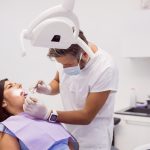TEETH WHITENING IN KENYA: OPTIONS, COSTS AND EXPECTED OUTCOMES
In our last essay we covered extrinsic stains (stains on the outer surface of teeth), how to prevent them and how they can be cleaned in order to deal with the discolorations. In this essay we are going to look at intrinsic discolorations (discoloration as a result of defects incorporated in the structure of the tooth).
Some of the causes include:
Increased uptake of water with excessive fluoride levels during the period where teeth are developing: fluoride in small amounts is useful to strengthen teeth and bones however in excess amounts leads to teeth defect commonly seen as ‘browning’ of teeth and its severity increases with increased fluoride levels. These problems are endemic meaning they are common in particular regions.However with increased use of borehole water in most of the urban area,this has changed and fluorosis is not localised in specific regions,
Fevers in children that may be as a result of infections: How do childhood fevers affect the colour of the teeth? Fevers affect metabolism and in a child who is developing this is seen in structures developing at that time. For teeth it appears are a band of abnormally colored tooth surface, that means during the period of time the cells were forming that region of the tooth, ‘their work was disrupted’. However normal tooth formation is resumed afterwards so it only appears as a band.
Consumption of some medications during tooth forming period when the foetus is developing in the womb: some medications e.g., Tetracycline when consumed during some stages of development may lead to formation of discolored teeth.
Genetic defects: sometimes due to genetic defects some people develop discolored teeth.
How do we deal with such discolorations?
Deep scaling and polishing are ineffective against such and so there are various ways where the teeth can be made whiter.
Masking – this is where the external surface of the discolored tooth is reduced a little bit and then white filling material is placed all around the teeth giving it a nice white appearance.
Microabrassion- this is effective in situations such as mild fluorosis where the tooth surface is exposed to an acidic medium which dissolves the defect.
Bleaching- commonly referred to as whitening, this is a process where the tooth is exposed to an oxidative compound which alters its light absorbing and light reflecting properties giving the teeth a whiter appearance. We shall dive deeper into it.
Situations where bleaching should not be done include
Discoloration due to some genetic defects
Tooth sensitivity
White spots
Deep microcracks
What does bleaching entail?
Bleaching can either be done in the dental clinic or at home with instructions from your dentist.
Home bleaching:
The process begins by taking the impression of the mouth(a mold of your teeth) to fabricate a tray specially suited for your teeth.
Once the tray is ready,our dentist will avail the tray to you and give the bleaching agent and instructions on how to use it.
In-Office bleaching.
This is done at the chairside and uses a higher concentration of the bleaching agent than the take home agent.
What are the costs?
Ranges between Ksh 20,000-Ksh 40000 depending with the method used.















